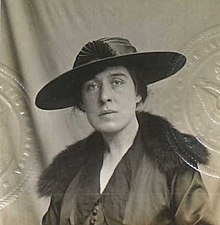
Anne Murray Dike (1878-1929) was an American doctor, chair of the American Committee for Devastated France from 1917 and recipient of the Croix de Guerre and member of the Legion of Honour. [1]

Anne Murray Dike (1878-1929) was an American doctor, chair of the American Committee for Devastated France from 1917 and recipient of the Croix de Guerre and member of the Legion of Honour. [1]
She was born Anne Veitch Murray in Edinburgh Scotland about June 8, 1878. She immigrated to the United States about 1908 in which year she married Francis Harold Dike, a Columbia graduate and instructor in French and English at MIT (1900-10) whom she divorced in 1914.

Anne Murray Dike joined philanthropist Anne Morgan in France. From 1917 to 1921 Morgan took residence near the French front, not far from both Soissons and the "Chemin des Dames" at Blérancourt, and ran The American Friends of France. It employed several hundred people, including domestic and foreign volunteers and financed in part from donations from the States. [2] Of seeing the French countryside during the war, Dike said in 1919, "You can travel in a motor going forward in a straight line for fifteen hours and see nothing but ruins". [3]
In 1924, Morgan and Dike both were made officers of the French Legion of Honor during a ceremony held at Blérancourt. [4]
Dike died on February 8, 1929, at the home she shared with Morgan at 43 Rue de Courcelles in Paris, due to complications of neoplastic myeloma. [5] She is buried in the village cemetery at Blérancourt.
The estate of Blérancourt was transformed into a museum and inaugurated in 1930, one year after her death. [6]
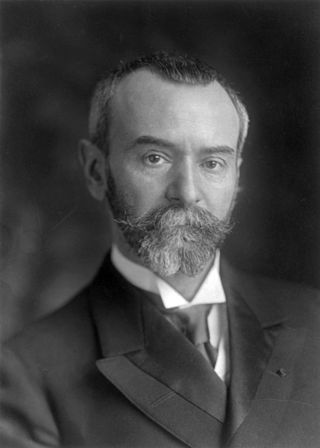
Jean Adrien Antoine Jules Jusserand was a French author and diplomat. He was the French Ambassador to the United States 1903-1925 and played a major diplomatic role during World War I.

Edith Madeleine Carroll was an English actress, popular both in Britain and in America in the 1930s and 1940s. At the peak of her success in 1938, she was the world's highest-paid actress.

Cécile Louise Stéphanie Chaminade was a French composer and pianist. In 1913, she was awarded the Légion d'Honneur, a first for a female composer. Ambroise Thomas said, "This is not a woman who composes, but a composer who is a woman."

Anne Tracy Morgan was an American philanthropist who provided relief efforts in aid to France during and after World War I and II. Morgan was educated privately, traveled frequently and grew up amongst the wealth her father, banker J. P. Morgan, had amassed. She was awarded a medal from the National Institute of Social Science in 1915, the same year she published the story The American Girl. In 1932 she became the first American woman appointed a commander of the French Legion of Honor.
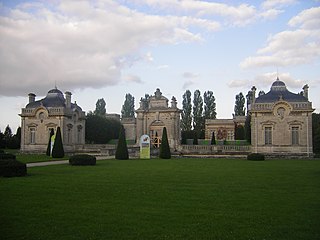
Blérancourt is a commune in the department of Aisne in Hauts-de-France in northern France.
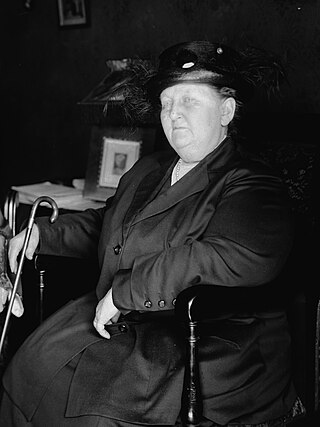
Elisabeth Marbury was a pioneering American theatrical and literary agent and producer who helped shape business methods of the modern commercial theater, and encouraged women to enter that industry. Since 1892, Marbury had been living openly in a lesbian relationship with Elsie de Wolfe, a prominent socialite and famous interior decorator.

Alfred-Henri-Marie Baudrillart, Orat. was a French prelate of the Catholic Church, who became a Cardinal in 1935. A historian and writer, he served as Rector of the Institut Catholique de Paris from 1907 until his death. He campaigned to rouse international support for France during the First World War, while in the Second World War he supported the Vichy regime and backed the Germans for leading the international struggle against bolshevism.
Mary Astor Paul Munn Allez was a Philadelphia socialite who was related to the Astor and Drexel families. During World War II, she helped the American forces in France.
Harriet Hallowell (1873–1943) was an expatriate American artist who lived in France for fifty years. She was born in Boston to a Quaker family. During World War I she remained in France and volunteered at a hospital. The hospital was near the home she shared with her aunt Sarah Tyson Hallowell, located in the village of Moret-sur-Loing, which borders the Forest of Fontainebleau.

Alva Erskine Belmont, known as Alva Vanderbilt from 1875 to 1896, was an American multi-millionaire socialite and women's suffrage activist. She was noted for her energy, intelligence, strong opinions, and willingness to challenge convention.

American Committee for Devastated France (1919–1924), also known as CARD, was a small group of American women who volunteered to help the French Third Republic recover from the destruction of The Great War

Blanche Edwards-Pilliet (1858–1941) was a French physician, medical teacher, and leading social reformer for women. She, along with Augusta Déjerine-Klumpke, was one of the first women to intern at a hospital in Paris.

Maud Hunt Squire was an American painter and printmaker. She had a lifelong relationship with artist Ethel Mars, with whom she traveled and lived in the United States and France.

Anne Harriman Sands Rutherfurd Vanderbilt was an American heiress known for her marriages to prominent men and her role in the development of the Sutton Place neighborhood as a fashionable place to live.

Frederick Hobbes Allen was an American international lawyer and naval aviator during World War I who was prominent in New York Society during the Gilded Age.

Mary Hannah Frances Ivens CBE FRCOG was an obstetrician and gynaecologist who was the first woman appointed to a hospital consultant post in Liverpool. During the First World War she was chief medical officer at the Scottish Women's Hospital at Royaumont, northeast of Paris. For her services to the French forces she was awarded a knighthood in France's Legion of Honour and the Croix de Guerre.
FIDAC was established in Paris in November 1920, at the initiative of the veterans from World War I predominant pacifists, such as Hubert Aubert, director in UNC , France, and in particular Charles Bertrand, Secretary-General of UNC and deputy in the French Parliament. They had the idea of uniting veterans’ associations established after the end of World War I in various allied countries into an international federation whose main purpose was to promote peace, continuously strengthen the brotherhood initiated on the battlefield, and provide help to the wounded, the disabled, widowers, war orphans, veterans, and also commemorate the heroes fallen in battles. Charles Bertrand, general secretary and future president of UNC in France, thus became the first president of FIDAC (1920–1924).

Harry Austen La Montagne was a French-American horse owner, artist, sculptor, war veteran and sportsman.

Andrée Viollis was a French journalist and writer. A prominent figure in news journalism and major reporting, she was an anti-fascist and feminist activist who was part of the French group associated with the World Committee Against War and Fascism. Viollis worked for various newspapers, including La Fronde, L'Écho de Paris, Excelsior, Le Petit Parisien, The Times, Daily Mail, Vendredi, Ce soir, and L'Humanité. She received several awards, including the Legion of Honour.
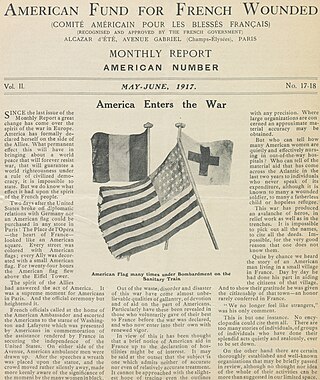
The American Fund for French Wounded (AFFW) was a private military relief organization founded by American women living abroad that provided aid to small hospitals in France, medical assistance for wounded French soldiers and civilians, and support for refugees during World War I. Headquartered in New York City, committees across the United States raised funds and collected dressings, blankets, pillows, clothing, food, and amusements for the organization. The AFFW worked closely with several similar organizations, including the American Red Cross.